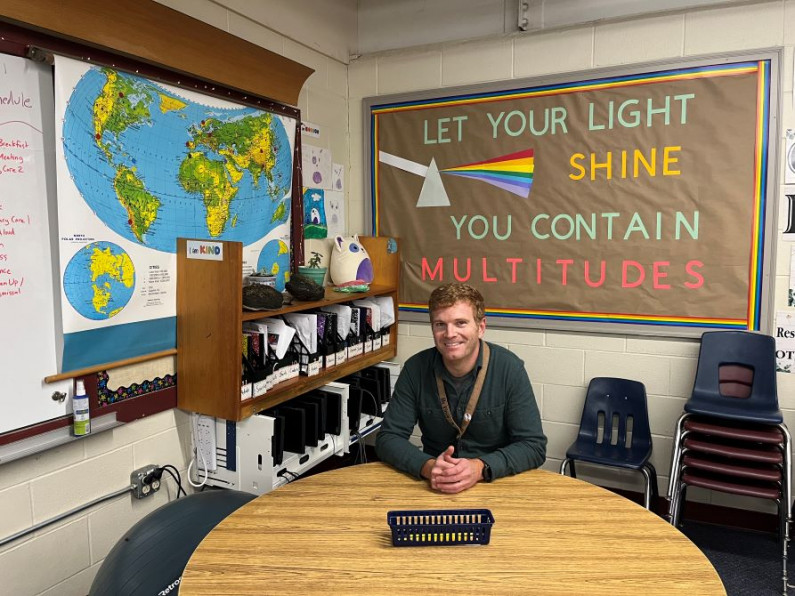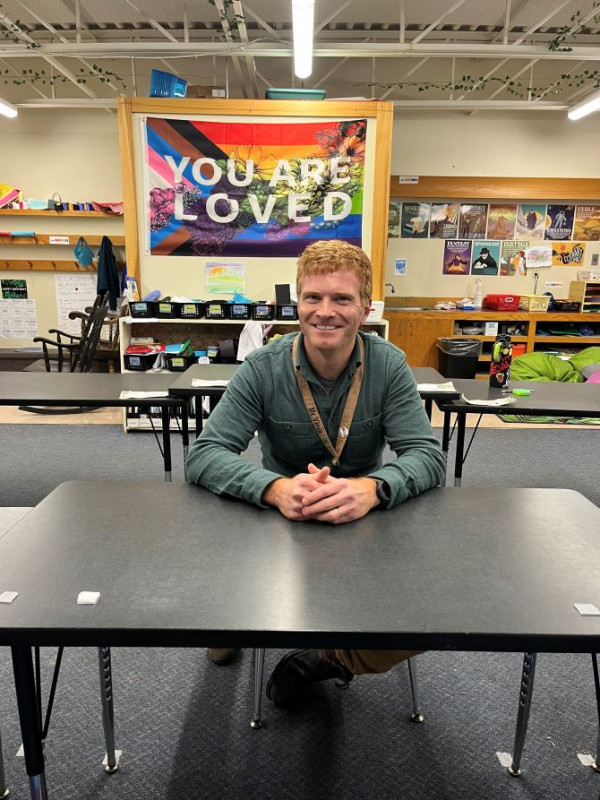Apprenticeship Program Helps Solve Teacher Shortage Crisis

Vince Razionale in his classroom.
Pilot program in Vermont’s Northeast Kingdom provides alternate route to teacher licensure
“I’m a career changer—I didn’t study education formally in school,” said Vince Razionale, who at 39 is pursuing his teacher licensure through a new apprenticeship program in Vermont’s Northeast Kingdom. The program helps individuals with bachelor’s degrees attain their teaching certification, while earning a salary and gaining practical experience in the classroom.
“When I was 23, coming out of college, I don’t know whether I would have had the stamina or professionalism to be as good of a teacher as I can be now,” he said. “I feel really at peace about who I am as a person and my place in this world, and my place in this community.”
But the path forward wasn’t always clear.
Razionale briefly considered a career in education after receiving his bachelor’s degree in ancient history in 2007. “It’s something I thought about but never pursued,” he said. “And then I ended up having kids and starting a family, and so it fell by the wayside.”
After moving to northern Vermont in 2011, Razionale worked for various food-related businesses, from cheesemaking to sausage-making, before reconsidering a career in education. He had served on his local school board for several years and was aware of the teacher shortage crisis.
To test the waters, he signed on as a substitute at several local schools. “You get to see lots of different ages—kindergarten, art, PE, middle school,” he said. “I liked it. After a few months I thought, alright, I can see myself doing this.”
But Razionale knew a traditional degree program wasn’t an option for him. “I’ve got two kids, I’ve got a mortgage,” he said. “I can’t just take a year off work. While appealing, that angle probably wasn’t the best fit for someone like me.”
So last spring, when he was offered a full-time teaching position in the fourth-grade classroom at Hardwick Elementary where he had been a long-term sub, he took the job on a two-year provisional license and then set about trying to figure out how to get fully licensed.
The timing couldn’t have been better.
Razionale soon learned about a new pathway to licensure—the Vermont Teacher Apprenticeship Program—designed for aspiring teachers like him who are serving on provisional licenses.
The program is phase one of a Northeast Kingdom “Grow Your Own” Pathways initiative, a collaboration between four nonprofits—the Vermont NEA, Vermont Agency of Education, Vermont Department of Labor, and Vermont Rural Education Collaborative—to develop and train teachers from the local community, while helping to build a stronger teacher pipeline.
When there aren’t enough teachers
Teacher shortages have been a growing problem in Vermont for over a decade, with fewer people entering the profession as veteran teachers retire or leave the field.
“The total number of teacher graduates has been cut by more than half,” said Andrew Prowten, assistant director of education quality at the Vermont Agency of Education. “In the 2023/24 school year, only 151 people received their initial teacher license through a traditional university-based prep program in Vermont.”
As the deficit of teachers is expected to continue, some see traditional education prep programs as an important but incomplete strategy. According to the 2023-2024 Most Promising Jobs Report put out by the McClure Foundation and the Vermont Department of Labor, teachers will continue to be the most in-demand profession in Vermont, paying above the state’s minimum wage, with a projected 7,850 job openings over the next decade.
A statewide problem, teacher vacancies are particularly severe in rural areas like the Northeast Kingdom where it’s harder to attract and retain qualified teachers. Sean McMannon, superintendent of the Kingdom East Supervisory Union, said he recently had a teacher accept a position and then pull out when they couldn’t find a place to live.
Other new teachers get a couple of years of experience under their belts at rural schools and then move on to larger towns and cities, Prowten explained.
As of October 2024, there were nearly 50 unfilled teaching positions in Northeast Kingdom schools, according to School Spring, a job posting site for educators.
When faced with these shortages, administrators are forced to place unprepared and unqualified teachers in the classroom, which not only affects immediate learning outcomes for students, but also can have long-term repercussions, as students miss foundational skills and knowledge necessary for future success.
“We know the most important school-based factor on student learning is the quality of the classroom teacher,” said Juliette Longchamp, director of professional programs at the VT-NEA, or teachers union. “That is the number one. Number two is the school leader.”
The scramble to find qualified candidates and manage substitutes diverts school administrators from their primary role of overseeing day-to-day operations. It also has a domino effect that dilutes student resources, explained Elaine Collins, superintendent of the North Country Supervisory Union. “You pull one person to cover another service, and someone’s going to do without because you can’t fabricate someone out of air,” she said.
McMannon said that two years in a row he’s had to utilize the district’s labor agreement with teachers to transfer teachers between schools to fill a position.
“This year we needed a middle school math teacher in Sutton, and one of our math teachers from Miller’s Run stepped up to go over there,” he said. “But it created a gap. So then we had to take another teacher who was doing intervention and push her into the classroom. So now what that means is students who are behind in math are not getting the extra support they need.”
From provisional license to certification
Provisional licenses are one way that districts fill vacant teaching positions. These two-year licenses enable individuals who haven’t completed the requirements for a teaching license to teach on a temporary basis.
“Last year we issued twice as many provisional licenses as five years prior, and we are on track to issue just as many, if not more, this year,” Prowten said.
While provisional licenses make it easier for districts to fill vacant positions, they put the onus on aspiring teachers to complete the licensure process before their temporary license expires.
This is unrealistic, explains John Castle, executive director of the Vermont Rural Education Collaborative, a nonprofit that supports rural education in the Northeast Kingdom’s eight supervisory unions/districts. “Here we have brand new teachers who have never taught before, and we’re throwing them in the deep end. They’re trying to be a teacher and meanwhile they’re also having to complete this massive portfolio to achieve licensure.”
Less than half of unlicensed teachers complete the licensure process, according to the latest data by the Vermont Agency of Education.
This was the inspiration behind the Vermont Teacher Apprenticeship Program. Castle and his fellow partners set out to create a more supportive, low-cost pathway for individuals to achieve initial licensure.
The origins of the project were partially funded by the McClure Foundation, an affiliate of the Vermont Community Foundation committed to career learning and workforce development.
“McClure Foundation funding was instrumental in us feeling like we had the ability to take on this work,” Castle said. He was able to devote substantial time to researching various models and putting forward a proposal to the Vermont Agency of Education for grant funding to formally engage in program development. After receiving approval in September of 2023, the partnership began building the pilot program.

Vince Razionale in his classroom.
A path forward for aspiring teachers
When the 28 teacher apprentices in the program’s inaugural class complete their coursework at the end of the school year, they will not only be fully licensed, they will be equipped with the skills and knowledge to be stronger at their jobs, explained Longchamp of the VT-NEA. She facilitates the program’s 144 hours of supplemental instruction, provided through a weekly virtual class and at-home assignments, and helps apprentices get their portfolios ready for review—the final step to licensure.
“While I’m teaching, I’m learning on the job throughout the course of the day and through my colleagues that I work with,” Razionale said. “And then I’m also taking this class that’s providing other learning and ways for me to be thinking about my practice of being an educator as the school year goes on.”
The program also offers on-the-job support for these new teachers as they navigate everyday challenges in the classroom and make progress toward achieving their competencies.
“There’s one mentor that’s assigned to them and is supportive throughout the entire length of the Registered Apprenticeship Program, which includes a full year of classroom teaching,” said Sarah Knight, senior program administrator for apprenticeships for the Vermont Department of Labor. “That piece alone is huge. It’s something we don’t have in the more traditional teacher pathways.”
Razionale’s mentor is the third-grade teacher down the hall, who taught both of his children. They usually meet at lunch or during recess. He said that during these first months in the classroom he’s leaned on his mentor for emotional support as much as anything else. “She knows all my students and can offer support in a very dynamic and compelling way,” he said.
Teacher apprentices who are rooted in the communities where they teach, bring a unique set of strengths to their profession, explained McMannon of Kingdom East. “Most of them have either worked in the school system or are connected to it,” he said. “When you have that foundation initially, I think you have a much better probability of having long-term success—of growing a teacher, of retaining them, and having good outcomes for students.”
Additionally, students benefit from the continuity and stability that comes from having teachers who are invested in their communities. Research shows that when they feel a connection to their teacher, students do better in school, explained Prowten of the Agency of Education.
“If your bigger cousin who you idealize is the one who’s teaching you, that teacher is going to be a lot more successful than someone new coming into a rural area from another place,” he said. “That community connection is really important, especially if we’re talking about the social and emotional learning and health that is so critical. I think it’s the most important thing right now for students.”
Razionale said he’s enjoying the colleagueship he finds at Hardwick Elementary. “People work in schools because they care about kids and they want to build a better future for the next generation and want to have a great community and local impact,” he said. “I can definitely see a path forward for myself.”
The post-baccalaureate apprenticeship program is the first of several new “Grow Your Own” pathway programs in the works. The next phase of development includes expanding the program to other school districts around the state, explained Knight of the Department of Labor.
“We want to support others looking to become licensed teachers, perhaps focusing on paraeducators and other school support staff already working in our schools, as well individuals in our local communities who would be very interested in this alternative pathway to becoming a teacher,” she said. “We’ll need to have some strong partnerships with post-secondary trainers to work with us to figure out how to provide the related instruction and degree programs in a more flexible, more affordable way that fits in with the apprenticeship model.”
Castle of the Vermont Rural Education Collaborative is excited about these additional routes to licensure. “People are entering the profession through nontraditional pathways,” he said. “If we want to attract new educators, we need to provide pathways that are affordable, accessible, and connected to their work.”